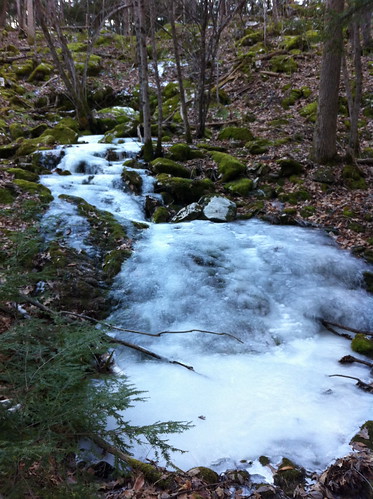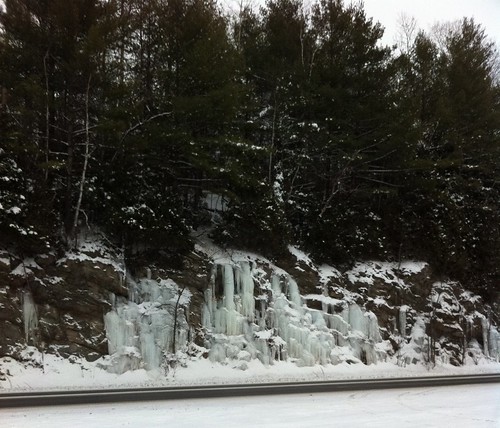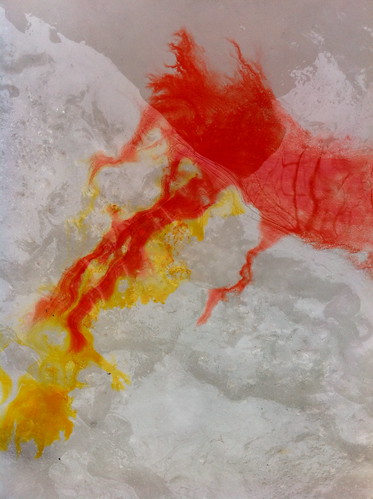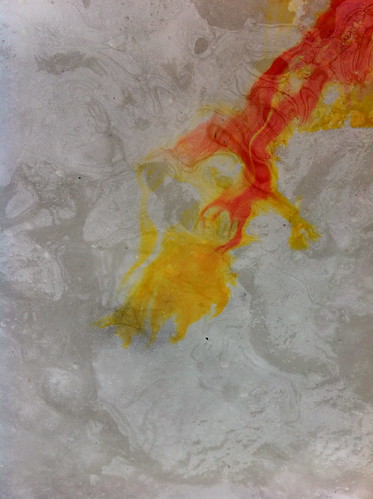
These apparently solidly frozen streams form every year in Vermont, but because this year has had very little snow, they've been more evident on the landscape than usual. The most commonly seen manifestations may be the huge blocks of ice that form along roadways, such as those below (photo from last year):

A few days ago I was driving up Highway 125 and the Middlebury River Gorge was full of these icy cascades apparently frozen in place in a cold shady area (I did not get a picture, since I was driving). It really does appear that a sudden freeze stopped a creek in its tracks, freezing it in place, but that isn't really what happens.
In most cases, these frozen features appear where seeps or springs bring water to the surface. Since springs (except hot springs, which don't occur in Vermont) maintain a constant water temperature year round, they don't freeze solid. Water continues to flow during very cold conditions and some of it freezes to objects around it, or to other ice, forming these complex and beautiful ice 'sculptures'. The features form slowly, not all at once, and are constantly changing.
The film of water that continues to flow over the surface of the ice is largely invisible, but with the addition of some dye, it's possible to watch the water slowly trickling along portions of the ice surface.


In other areas, there is moisture on the surface but it does not appear to be moving very fast in any one direction:

Because these features are made up of solid ice, the ones in shaded, cold hollows can last much longer than the snow around them. This winter has been much milder than average, but has still experienced below-freezing conditions for the majority of the time, so these features have become quite notable in some areas. I've seen them persist well into April in some years, and in very protected locations, such as caves and deep hollows, they can last even longer.

Making the water flow visible is fascinating. But tell me that is food colouring, and won't harm wildlife downstream?
ReplyDeleteOh, good, comments are working again! For a while, I couldn't see the comments section of this post. Anyway, to answer your question:
ReplyDeleteAny dye I use to color icicles or runoff is food coloring - and never more than a drop or two. I've done some research and haven't been able to find any evidence that there are any harmful effects of food coloring, aside from maybe if you drank a few bottles of the stuff. I use it often to illustrate movement of water where it isn't otherwise easily visible - for more, see http://www.flickr.com/photos/inyo395/sets/72157625946712704/ . If anyone does know of harmful effects of food coloring or has ideas about other dies that might work better (but would not significantly alter the freezing temperature of water) let me know! I've considered making my own dye by boiling down natural foods such as beets or red cabbage, but haven't gotten around to trying it yet, especially since this winter offered few opportunities for icicle coloring. Also, some natural dyes use salt which for obvious reasons can't be used on icicles and other such formations.
Thanks for your comment!
I only check that email on Wednesdays. We're both glad to SEE the comments.
ReplyDeleteallbodyboarders. Menu. Bodysurfing; Boogie Boards for Adults. Evelyn November 17, 2018 Bodysurfing No Comments. If you’re enthusiastic about the beachside water sports and like to ride the waves. Then you might be familiar with the boogie Read More Here
ReplyDelete